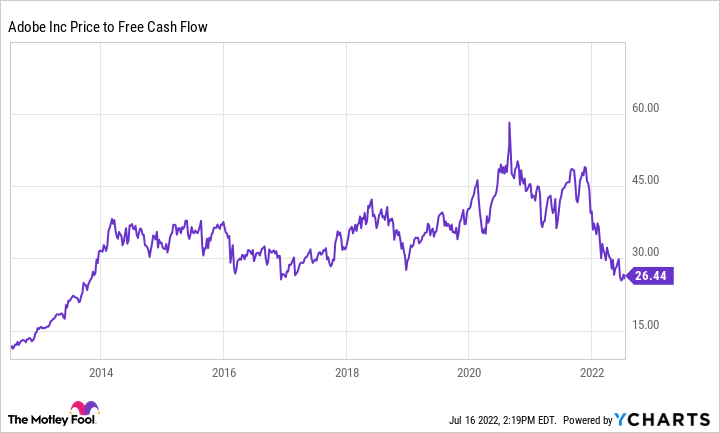One definition of supercharged is "extremely powerful or fast." Today's focus is on the powerful side of things -- at least as it relates to investing.
While this focus could mean various things to a publicly traded company, this article will examine three stocks with tremendous free cash flow margins. Free cash flow is calculated as cash from operations minus capital expenditures -- meaning that the higher a company's free cash flow margins are, the more powerful its operations are in theory.
These businesses are authentic cash machines, sporting free cash flow margins between 35% and 48%. And they could triple over the next decade, despite the market's current volatility.
1. Adobe
Driven by its mission to "enable the world's digital experiences," creativity-fueling Adobe (ADBE -0.70%) offers investors a compelling investment proposition riding the "digitization of everything" megatrend. Operating through its three business lines -- Adobe Creative Cloud, Adobe Document Cloud, and Adobe Experience Cloud -- the company seemingly has a product for everyone.
With its Creative and Document Clouds boasting over 600 million monthly active users (MAUs) and its Experience Cloud having over 4,000 partners, Adobe has built a leadership position amid the world's digital transformation. Whether used by content creators, business professionals, or large enterprises, its importance to the economy has caught the market's attention.
Rising more than 1,100% over the last decade, shares of Adobe outpaced its free cash flow growth of 445% over the same time, fueled by the 2012 launch of its Experience Cloud and its subsequent expansion.
Ten years later, Adobe believes its Experience Cloud will have a total addressable market (TAM) of $110 billion by 2024, or more than half of the $205 billion TAM it sees for the entire company. Growing sales by 18% year over year in the second quarter of 2022, Adobe Experience Cloud helped fuel companywide sales growth of 14% over the same time.
Along with its outsize TAM, the Adobe Experience Cloud is essential thanks to its enterprise focus, partnering the company with some of the largest corporations in the world. As the leader in this market -- with Gartner ranking it the No. 1 company in the customer experience and relationship management categories -- Adobe looks poised to build upon these already sticky sales.
Finally, thanks to its 33% drop year to date, Adobe trades at a low price-to-free-cash-flow (P/FCF) ratio it has not seen for over five years.

Data by YCharts.
Trading at a P/FCF of just 26 while having grown FCF by 24% annually over the last three years, Adobe looks to be a fantastic cash creator sporting a fair price.
2. S&P Global
With its $44 billion acquisition of IHS Markit, S&P Global (SPGI 0.36%) showed its intentions to diversify beyond the S&P 500 Index, for which it is most well known. This merger now creates a behemoth in the financial information industry, which will consist of the following six business segments (shown with each's respective 2021 revenue):
- Market intelligence ($3.9 billion)
- Ratings ($4.1 billion)
- Commodity insights ($1.7 billion)
- Mobility ($1.2 billion)
- S&P Dow Jones Indices ($1.3 billion)
- Engineering solutions ($391 million)
Recording a 2% revenue increase year over year for Q1 2022, S&P Global's growth slowed thanks to a 15% decline in its ratings segment. This drop was somewhat expected by investors, as bond issuances tend to decrease during macroeconomic uncertainty and rising interest rates like we've seen recently.
However, management suspended 2022 guidance due to further concerns around its ratings segment, as it believes issuance for rated bonds could fall more than 30% compared to the previous year. This news sent the stock down over 5% and extended its 26% decline in 2022.
Despite this drop, once the markets normalize and S&P Global fully integrates its IHS Markit purchase, management expects the company to generate roughly $5 billion in free cash flow by 2023.

Data by YCharts.
Should it reach this ambitious goal, it would trade around 24 times FCF -- an intriguing price for a Dividend Aristocrat. On top of this valuation, S&P Global has increased its dividend for 49 consecutive years.
As it plans to pay out at least 85% of its FCF in dividends and share repurchases to investors, it is a great candidate to triple in 10 years.
3. InMode
Through its proprietary radio frequency (RF) technology, InMode (INMD 0.28%) offers non- and minimally invasive procedures that are an alternative to many older plastic surgery techniques. Having 10 unique product platforms and dozens of handpieces that work with them, InMode has clinically tested processes that can tighten skin, permanently remove hair, and much more.
While InMode's sales growth slowed to "just" 31% year over year in Q1 of 2022 -- compared to 51% annually over the previous three years -- its share-price drop of 62% this year seems relatively unfair.
However, this decline has the company trading near all-time lows on a P/FCF basis.

Data by YCharts.
At just 13 times FCF, InMode's incredible FCF margin of 48% and consistent growth seem like a fantastic opportunity.

Data by YCharts.
Furthermore, InMode's consumables and services revenue increased by 79% in Q1, accounting for 16% of total sales. These growing sales create a tremendously valuable source of recurring revenue for the young medical technology company, highlighting the long-term prospects of its modern-day razor-and-blades business model.
While InMode will need to continue its innovative track record to stay ahead of its peers, its strong cash generation appears relatively cheap today -- potentially leading to a three-bagger sooner than expected.





